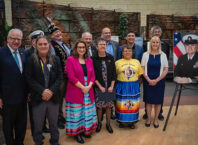The copper rush in northeastern Minnesota made the news in late July, when Canadian-based Duluth Metals inked a partnership deal with Antofagasta, a Chilean-based mining firm, to develop what an industry source called a “large scale copper-nickel-platinum-palladium-gold project.”
Antofagasta is putting up $130 million for a 40 percent stake in the joint venture, Twin Metals Minnesota LLC.
The Nokomis Project, as this proposed sulfide mining operation is called, has set off alarm bells among environmentalists, who point out that its location on the South Kawishiwi River poses a threat to the nearby Boundary Waters Canoe Area Wilderness (BWCAW).
Earlier this year I wrote about another project, PolyMet Mining’s proposal to open the first sulfide mine in Minnesota – in a location within the 1854 Treaty Ceded Territory. Briefly, this type of mining across the western United States has a track record of leaving behind toxic metals and significant water pollution.
The tribal signatories to the 1854 Treaty – the Fond du Lac, Bois Forte and Grand Portage Ojibwe bands – are “cooperating agencies” for the environmental review of the Polymet project near Hoyt Lakes.
As I reported in March, the federal Environmental Protection Agency (EPA) rejected the draft environmental impact statement (EIS) for the Polymet mine, sending the company back to the drawing board.
In late July I spoke with Nancy Schuldt, water projects coordinator for the Fond du Lac Band’s Office of Water Protection. I opened the telephone chat with Schuldt by asking her to outline the Fond du Lac band’s concerns about sulfide mining. “How long do you have?” she responded.
She mentioned first that Fond du Lac is one of the tribes in the U.S. that has “federally approved water quality standards. We are essentially a water quality regulatory authority; and we are downstream of the existing taconite mines,” and NorthMet, Polymet’s proposed sulfide mine.
She then mentioned the 1854 Treaty, which reserved “in perpetuity” (forever) the previously mentioned bands’ rights “to hunt, fish and gather from those lands that were ceded to the U.S. government. The exercise of treaty rights is an important issue… pretty central to maintaining and asserting sovereignty,” and allowing band members to preserve a “culturally traditional lifestyle” in the modern day. On this latter point, for example, there is the harvesting of manoomin, wild rice.
Schuldt said that the State of Minnesota has acknowledged a decline in wild rice. She also pointed out that Minnesota “has a single… criterion in their water quality standards for the protection of wild rice… a sulfate criterion of 10 milligrams per liter.”
Pollutants from existing taconite mining operations, carried into the Fond du Lac Reservation by the St. Louis River, have elevated sulfate in surface water; and Schuldt pointed out that PolyMet proposes to do its processing “on the old LTV [taconite] site, and they already have a nasty leaking tailings basin that has a high sulfate discharge. [PolyMet’s] production is only going to make that worse; and there are wild rice waters in the vicinity of their proposed discharge.”
Beyond the Twin Metals and PolyMet proposals, a veritable copper-nickel rush is on up north. Schuldt mentioned that Franconia Minerals is doing “significant exploration” at Birch Lake, which focuses on copper-nickel deposits underneath the lake. Another mining outfit called Teck Cominco, which is based in Vancouver, B.C., holds mineral leases from the state and private owners on the Mesaba deposit. And Rio Tinto, the parent company of Kennecott, is exploring aroud Tamarack, which Schuldt said is near Fond du Lac but not in the 1854 Treaty Ceded Territory.
Betsy Daub, policy director for Friends of the Boundary Waters Wilderness, told me that there are 100 permits to explore around Birch Lake, “right in that little pocket.” She said that both the Twin Metals and PolyMet proposals are “worrisome” because of the risk of water pollution.
In regard to the official endorsements for sulfide mining, she allowed, “Politicians have sort of stepped in line to support Polymet.” However, after the EIS was rejected, Daub noted that there have been a “few voices” saying that this new type of mining, if approved, must be done right.
Daub also mentioned that her group has been working closely with the Fond du Lac and Grand Portage bands. She said that the Ojibwe bands “hold a key and important role” in offering a critical point of view in the environmental assessment of mining projects.
Amid the lingering recession and bleak employment picture, there will be concerted pressure to boost any economic development scheme for northeastern Minnesota, even projects like sulfide mining that pose a huge downside of environmental degradation.
The mining juggernaut has come to Minnesota, and a popular movement is needed now to counter misbegotten plans to rip up the woods and wetlands for short-term profit and leave a devastated landscape behind.






